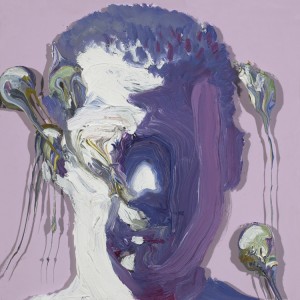Personal Identities / Contemporary Portraits
November 25, 2010 | By Jesse Hamlin
 Michael Schwager was working at the San Francisco Museum of Modern Art in 1985 when Eric Fischl’s famous life-size “Portrait of the Artist as an Old Man,” painted the year before, entered the collection. He was struck by the power and beauty of the image – a startled-looking old man wearing nothing but a shirt and slippers standing in a Van Gogh-like landscape before a blank canvas – and by the idea of an artist in his 30s picturing himself in his twilight years.
Michael Schwager was working at the San Francisco Museum of Modern Art in 1985 when Eric Fischl’s famous life-size “Portrait of the Artist as an Old Man,” painted the year before, entered the collection. He was struck by the power and beauty of the image – a startled-looking old man wearing nothing but a shirt and slippers standing in a Van Gogh-like landscape before a blank canvas – and by the idea of an artist in his 30s picturing himself in his twilight years.
“It has this great presence and poignancy,” says Schwager, an art history professor at Sonoma State University, standing in front of Fischl’s oil-on-linen painting in the University Art Gallery. “At the time, Fischl was known for his kind of naughty scenes of young boys and older women, and disturbing images from his childhood. I can’t think of another self-portrait he did.”
Inspired by Rembrandt’s late self-portraits, the work was high on Schwager’s list when he began putting together “Personal Identities/Contemporary Portraits,” an engaging exhibition that encompasses a wide range of artists, ideas and media. It explores the complexity and ambiguity of portraiture in the era of Facebook, Photoshop and the blurring of cultural and gender boundaries, when images and identities are in flux.
Walking through the galleries, you encounter famous faces, blurred and vanishing faces, anonymous figures, digital hybrids and even your own visage, captured live on camera and playing on LCD screens. Andy Warhol’s famous silkscreen images of Richard Nixon and Marilyn Monroe share space with Ray Beldner’s stitched-dollar-bill riff on Warhol’s Mick Jagger. On the opposite wall hangs Ray Turner’s “George,” a grid of 16 lusciously painted oil-on-glass images of the same mutable man. One’s a smear of greens, white and mauve; another has blue eyes and a flaming yellow face; a pinkish face fades away.
Elsewhere, you come across British sculptor William Tucker’s “Our Leader,” a lumpy abstract bronze that suggests an ear here, perhaps a nose there. Rigo’s sardonically political image of an American Indian – the word “Missile” refers to the U.S. military’s Tomahawk missile – is made of multicolored pushpins. The Vietnamese-born artist Binh Dahn’s “Ancestral Altar #12″ bares the images of butterflies and anonymous Cambodian political prisoners, printed on leaves through the natural process of photosynthesis (the artist puts negatives on leaves and exposes them to sunlight).
A rare Robert Bechtle self-portrait, the exquisite 2004 charcoal drawing “RB on De Haro Street,” appears in a room with a big Chuck Close self-portrait, a print-on-wood version of Raymond Saunder’s famous collaged-and-scribbled-on painting of the storied black boxer Jack Johnson (Saunders added new doodles and ephemera to the print), and Deborah Oropallo’s gender-bending digital picture of Napoleon overlaid with a sexy barmaid who wears similar white silk stockings.
“You have issues of race, gender, age and social class all coming through these various portraits, either directly or subtly,” says Schwager, who wanted to “show the range of what a portrait can be.” Declared dead by some modern art critics 50 years ago, portraiture, which Warhol was instrumental in reviving in the 1960s, and became a staple of feminist and postmodern art, “came back with a vengeance.”
Schwager wanted to show the Micks and Marilyns cheek to jowl with images of ordinary people and outsiders, like John Sonsini’s dignified, painterly portrait of a Latino day laborer standing on the street with all his belongings (the modeling of the shoes brings Van Gogh to mind), and Catherine Opie’s photograph of the cross-dressing San Francisco artist Jerome Caja.
Standing in front of Lincoln Schatz’s computerized “I, You, We,” you see the reverse, real-time image of yourself on three LCD monitors, mixing and merging with people who previously stood before the piece. The computer software continually recycles and mixes the images caught by the camera; a month from now, you’ll crop up in the company of people who saw the work that day and months before.
“The piece is creating a portrait of us as we look at it. It’s a constantly shifting, evolving portrait,” says Schwager. He hopes the show, the most ambitious in his 19 years at Sonoma State, “gets us to stop and think about who we are, who the person next to us is, how we see ourselves and how others see us.”
Personal Identities/Contemporary Portraits: 11 a.m.-4 p.m. Tues.-Fri. Through Dec. 12. University Art Gallery, Sonoma State University, Rohnert Park. Free. (707) 664-2295. www.sonoma.edu/artgallery.